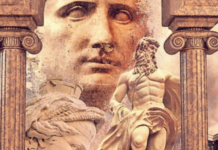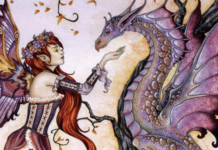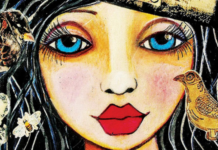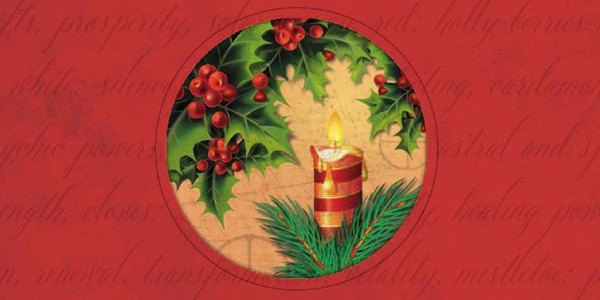
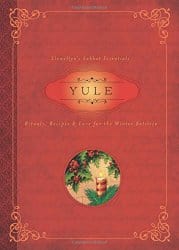 Yule: Rituals, Recipes & Lore for the Winter Solstice, by Susan Pesznecker
Yule: Rituals, Recipes & Lore for the Winter Solstice, by Susan Pesznecker
Llewellyn Worldwide, 978-0-7387-4451-3, 227 pp. (incl. correspondences for Yule, further reading, bibliography, and index), 2015
With its festive red cover, the beautiful and compact paperback, Yule: Rituals, Recipes & Lore for the Winter Solstice, by Susan Pesznecker delves into this holiday full of reflection and revelry. Its pages are full of information about symbols, traditions, history, recipes, activities, and crafts (both magical and mundane), outlined in a bite-sized, fast-paced, and informative way.
Following the easy-reference format of the other books in Llewellyn’s Sabbat Essential series, Yule consists of nine sections: Old Ways discussing the history of Yule; New Ways which includes modern traditions and ways of celebration; a Spells and Divination chapter that provides instruction for talismans, charms, and other magick work; the Recipes and Crafts section teeming with recipes (eggnog!) to candle making; a Prayers and Invocation section full of prayers and meditations; a Rituals of Celebration section for any number of celebrants from solitary to family or group; a useful Correspondences for Yule section which lists key words, dates, figures, and other important information, and a Further Reading section.
Yule (along with Samhain) is my one of my favorite celebrations. Like Samhain, it encompasses dark and light, rebirth and reflection, celebration and silence. There’s something about the juxtaposition of these aspects that lends to the richness of the holiday season, and a sense of completeness. Yule encompasses many weeks, stretching the spirit of the season well into the new calendar year.
As the guide begins, Susan Pesznecker addresses our inherent need to hibernate during this season — to sync with the cycle of nature and become still. In past times, humans woke up with the sun and retired as it dipped below the horizon. Our diets and our actions reflected what the earth provided. Today, she asserts, we don’t change our routines — not the ways in which we eat nor the ways in which we behave. This puts us at odds and out of touch with nature, the natural cycles, and ourselves. Instead of raging against the darkness at this time of year, it would do us well to embrace it.
With that said, Yule is also about light in the darkness, that spark that lights our way in our bodies and souls. Whether in the form of the Yule log, the symbolism of the winter king, or candlelight, the season supports the promise of light’s return after a period of darkness.
In the first chapter, within the first few pages of the book, the author quickly explores the academic difference between Winter Solstice (“sun stands still”) — an astronomical alignment — and Yule, which is “typically linked to a number of religious celebrations and religious traditions.”1 The term Yule itself comes a variety of languages, including (but not limited to) the Old English geol, the Old Norse word jól, and can refer to a number of different festivities from Christmastide to Odin’s Wild Hunt.
The cycles of Yule are also explored: the astronomical cycle of the winter solstice and how it works scientifically, to its mythological cycles: its goddesses, namely, the queens, mothers, and heroines from Norwegian, Saxon, Celtic, Greek, and Roman traditions such as Frau Holle or Holda, and its gods, or kings, fathers, and heroes from Etruscan, Roman, Celtic, and Greek traditions.
With the female deities, Penzseck points out that they represented the fierceness of the season: the Celtic Cailleach who holds sway from October 31 (Samhain) to Beltane on May 1 and Skadi, the Scandinavian goddess of winter, while the male deities such as Mithras, Apollo, and Saturn represent “the return of light and vigor to the world.”2
The similarities between the Mithras figure and myth (among others) and Jesus and the Nativity story are also discussed, as the author points out that the winter kingship tradition is everywhere, including the myths of King Arthur, Gawain, and the Green Man. Because we all engage in and share this, is a key component to the winter celebration. It highlights the fact that our cultural and spiritual traditions are shared, as one borrows from the other. So much of the Christian celebration is also the celebration of long-forgotten rituals and stories, as Mithras and Osiris are.
What never gets tiresome is the overlap in origins and eventual melding of so many seasonal stories and beliefs. It demonstrates the rich, shared heritage of humanity, our collective unconscious, our love of layered stories and heroic figures, regardless of gender and source. Celebrations involving Yule, Solstice, Saturnalia, Midwinter, Christmas, 12 Days, New Year’s, and so on, are threads of light which intertwine into a glittering garland of gaiety and contemplation.
With the winter solstice, we face the longest night of the year. In times past, bonfires blazed, logs burned in fireplaces, and candles were lit. In modern times, that aspect is the same. Pesznecker relates that today, around the world, solstice is the time to ignite the light within and outside of ourselves. In Japan, bonfires are lit on Mount Fuji on the solstice “to welcome the return of the rising sun, Japan’s national symbol,”3 while Iranians celebrate Yalda, signifying the battle between light (good) and darkness (evil).4 With lights ablaze, gatherings of family and friends keep fires burning and stay up all night, telling stories, feasting, and in the morning welcoming the return of the sun.
The season allows many choices in celebration, from the riotous antics of misrule to the more gentle greetings of caroling, from contemporary gift-giving to the ancient well-wishes of wassailing, and from light in many forms, from crackling Yule logs to the soft-glow of luminaria. It seems the possibilities for Yuletide cheer are almost endless.
The symbols of the season hold special meaning, and the author provides paragraphs full of information on the significance of candles, colours, guising, gift-giving, and many other points of the holiday — including green.5What’s the season without greenery? Evergreens, mistletoe, holly, and ivy signify life in the midst of the barren and bleak landscape of winter. There is something invigorating and affirming with the scent of evergreen permeating the home — that and the smell of hot bread and gingerbread cookies.
Yule is the time for magick. Pesznecker provides robust sections in Yule addressing spellcraft, prayers, and magical as well as mundane workings. As Yule is the point where the dark time tips in favor of the light, it’s another opportunity for cleansing, sweeping out the old and stagnant into the new and vibrant. A particular favourite is “The Holy Midwinter Nights Meditation,”6 inspired by Carl Jung, Rudolf Steiner, and Joseph Campbell, in which one meditates upon a particular aspect and focus over many nights, for however long one chooses. It’s a multi-part meditation utilizing props such as pictures of loved ones, personal memorabilia, etc.; as well as readings, reflections, and journalling. On night one, for example, it’s suggested that “Soul touch” be the focal point: where do you come from? Where was your soul? Where do you go next? On subsequent nights other focus aspects such as balance, gratitude, love, patience, and rebirth are suggested.
As with Samhain, we find ourselves at a threshold on Yule that continues into the calendar New Year. Throwing open the front door at the stroke of the new year to welcome it into our lives or welcoming visitors across your threshold on the first day of the year both hold their own magick.
For me, colourful decorations (especially if they’re shiny and sparkly), crafts, baking, and gift-giving provide focus and allow for the outward manifestation of the season’s joy. There really is a special magick to creating a gift from scratch, whether it’s ultra-cool ice candles — for which the author provides instruction,7 creating delectable pies and drink, or transforming your home inside and out into a magical wonderland. Pesznecker offers wonderful recipes for food and fun. Her all-ages wassail recipe8 with optional brandy sounds scrumptious, and gift-giving recipes for crafting a hot chocolate kit,9 mulling spices,10 and bath salts,11 are great ways to add a touch of “you” into Yule gift-giving!
Like sun on snow, Yule sparkles with the sacred and secular aspects of the season. Suggestions for celebrating, crafts, spells, and study makes Yule a fun and informative read and reference. Rebirth and renewal, reverence and revelry, reflection and reconnection with ourselves and with others, and the eventual return of light are what makes this time so magical and awe-inspiring in its myriad opportunities for merriment.
- p. 17 [↩]
- p. 26 [↩]
- p. 44 [↩]
- p. 45 [↩]
- p. 132-135 [↩]
- p.155 [↩]
- p. 138 [↩]
- p. 112 [↩]
- p. 123 [↩]
- p. 125 [↩]
- p. 127 [↩]


